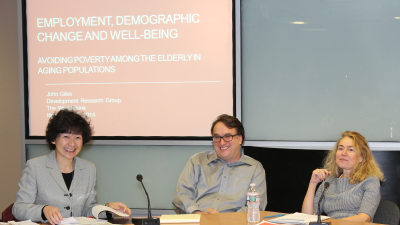The aging of populations in countries around the world poses a challenge both to ensure the well-being of the elderly and to identify sustainable ways to expand pension systems. In few places is the challenge more pressing than the countries of the East Asia and Pacific region, where rising dependency ratios—the fraction of elderly relative to the working age population—are forcing tough trade-offs for both families and policy makers.
At the November Policy Research Talk, John Giles, senior economist in the World Bank’s research department, discussed what the latest research tells us about how these trade-offs are being made, how policy reforms are making an impact on the well-being of the elderly and incentives for work, and identified some potentially promising untapped areas of policy reform. The Policy Research Talks are a monthly event held by the research department to foster a dialogue between World Bank researchers and operational colleagues.
“Increased longevity often makes the formal pension systems unsustainable as fewer workers have to support a larger population of the elderly. For those in the informal sector, the challenge is equally large, as workers are often unable to formally retire, making the elderly dependent on their children,” said World Bank Research Director Asli Demirguc-Kunt, who hosted the event. “So the big challenge for policy makers is how to design sustainable social protection systems that are not going to crowd out private support.”
Drawing on data from across the East Asia and Pacific region, Giles demonstrated the importance of private support to the well-being of the elderly—especially those who live in rural regions where workers are much more likely to be engaged in the informal sector, lack a formal pension, and live below the poverty line. In a range of countries from China to the Philippines and Thailand, private support to the incomes of the elderly help keep many above the poverty line. For example, in Thailand household survey data from 2011 indicate that the absence of private support—all else equal—would nearly double the percentage of elderly living below the poverty line.

